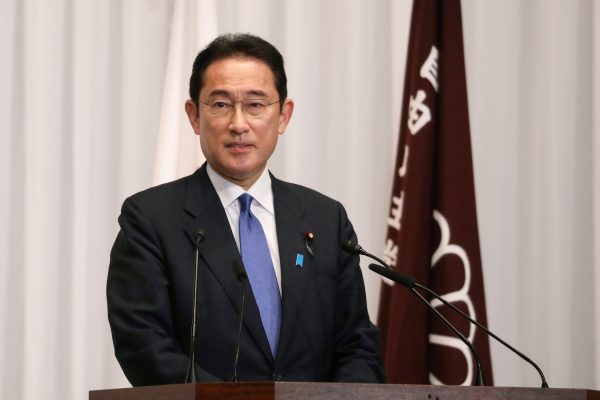Some of the themes debated during the LDP leadership election were unsurprising, such as Japan’s need to better secure its southwest maritime domain and resist Chinese attempts to undermine the status quo around the Senkaku Islands. The candidates also debated legally and militarily enabling Japan’s Self-Defense Forces (SDF) to strike military positions attacking Japan from foreign territories — an increasingly perennial discussion given the rapid pace of missile testing in the region.
Other themes were more surprising. Legislative changes in 1999 and 2015 quietly raised the possibility of Japan contributing — alongside the United States — to Taiwan’s defence, but only recently has official discussion of this possibility been raised in public. The LDP race added more voices to the chorus in favour of Japan doing more to support Taiwan’s security. An ally of former prime minister Shinzo Abe and now LDP policy chief, Sanae Takaichi, even held an online discussion with Taiwan’s President Tsai Ing-wen.
Takaichi stood out in the contest by saying Japan should meet NATO commitments to spend 2 per cent of GDP on defence. Kishida was less ambitious, but committed to an early review and better resourcing of Japan’s Mid-Term Defence Plan, reciting the mantra that he would not be bound by Japan’s informal 1 per cent of GDP defence spending marker.
As prime minister, Kishida announced work would begin on revising Japan’s National Security Strategy and other defence-related policy documents to reflect new party positions. Equally, the LDP’s House of Representatives election manifesto promised a ‘major strengthening’ of Japan’s defence capabilities from 2022 onwards. It also promised to enhance the Japan Coast Guard and its ability to cooperate with the SDF in light of concerns over China’s recent maritime police legislation, and its provisions on the use of weapons.
The manifesto also indirectly notes the need to revisit a foreign territory strike option, which Kishida reaffirmed as prime minister. Avoiding mention of Taiwan’s defence, the manifesto identified Taiwan as sharing universal values with Japan and supported its entry into the Comprehensive and Progressive Agreement for Trans-Pacific and the World Health Organization as an observer.
The manifesto’s reference to the NATO defence spending target probably garnered the most media attention. But assuming annual economic growth of 2 per cent, this would require consistent year-on-year increases of 9.5 per cent for 10 years, or 7 per cent for 15 years. Even reaching the halfway point of 1.5 per cent of GDP would require defence outlays to compound between 5 and 6 per cent per annum.
Unless the Japanese government truly embraces heterodox ideas that its monetary sovereignty releases it from having to worry about debt financing pressures arising from future social spending commitments, this would require severe cuts to other spending portfolios. Furthermore, rather than laying out a path to a specific spending target, the LDP manifesto only indicated its ‘aim’ to increase defence spending by ‘keeping in mind’ the NATO commitment. This vague commitment was also tucked away in the ‘policy bank’ at end of the manifesto in literal fine print.
How much of this reflects genuine commitment rather than domestic and geopolitical signalling is debatable. This rhetoric has nevertheless raised expectations domestically and internationally, meaning that reverting back to incremental increases in defence spending of around 1 per cent annually would be problematic.
Still, even modest increases in the rate of growth could be hard to achieve. The LDP must first convince coalition and key electoral partner, Komeito. Komeito, however, signalled its disapproval of big defence increases before and after the general election. Komeito leader Natsuo Yamaguchi claimed that the public opposed large defence increases, and the government should instead prioritise ‘areas that support people’s lives, such as social security, education and child-care’. He also implicitly warned LDP hawks to temper their expectations when he welcomed Kishida as a fellow ‘dove’, emphasising Kishida’s heritage as the leader of the LDP’s moderate and pragmatic Kochikai faction.
While the Japanese public may appear dovish on security issues and fiscally hawkish, public sentiment towards defence strengthening has recently shifted towards lukewarm support. The last decade has also shown that fiscal austerity and the national debt are not overriding public concerns. Being able to better address strategic insecurities arising from the deteriorating external environment may instead depend on the government successfully assuaging the Japanese public’s economic and political insecurities.
It could do this by demonstrating that it is serious about growing the economy in ways that benefit the middle class before allowing defence to make greater claims on economic resources.
A serious attempt by Kishida at implementing his ‘new Japanese capitalism’ agenda by coupling increased social support with substantial government investments to stimulate equitable growth would greatly help. If successful, it would not only increase the economic resources available to support Japan’s defence, but would politically strengthen Japanese leaders’ hands to make bolder, longer-term defence changes. Neither instinctively anti-China nor ideologically committed to controversial revisionist positions, Kishida may also be well placed to provide political reassurance even while making bolder moves on national security than was possible during the Abe era.
Kishida still needs to manage the post-COVID-19 recovery process by balancing multiple demands emanating from within the coalition government. But if he retains his political strength beyond the upper house election in July 2022, Kishida will be positioned to continue the process of defence policy change in Japan — should he want to — with defence spending the next target.
Corey Wallace is Assistant Professor at Kanagawa University.

